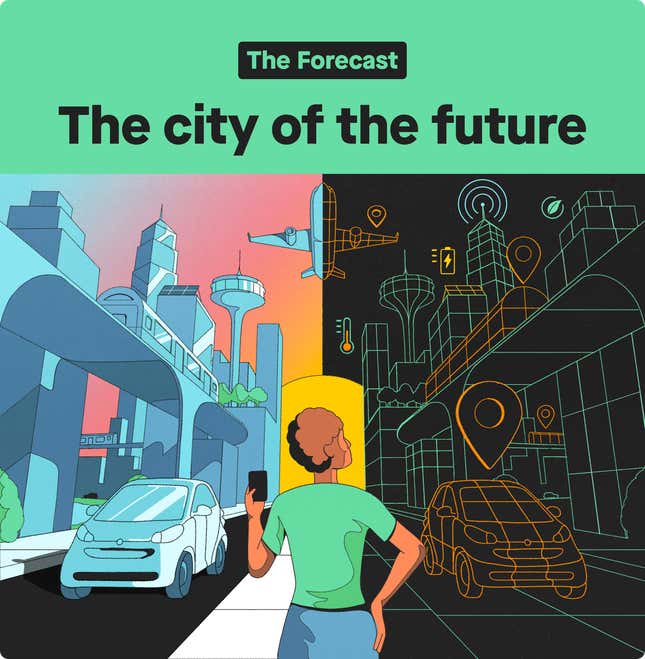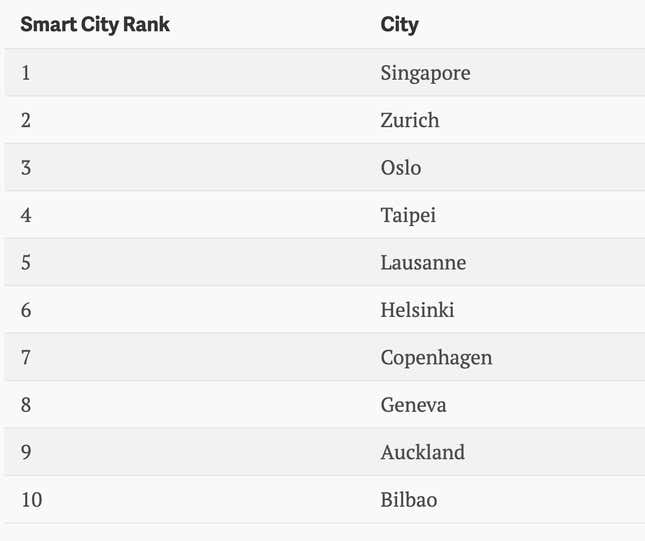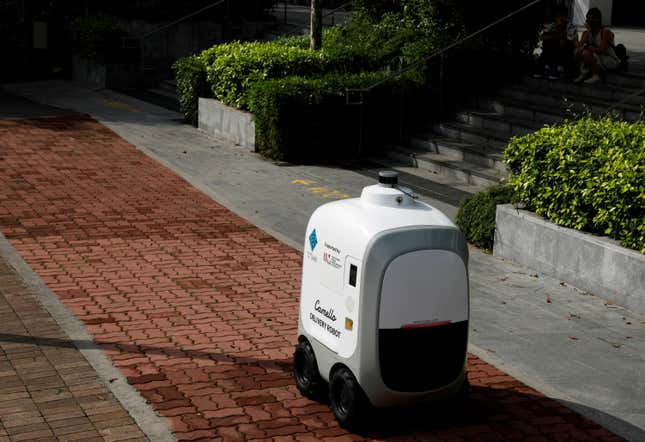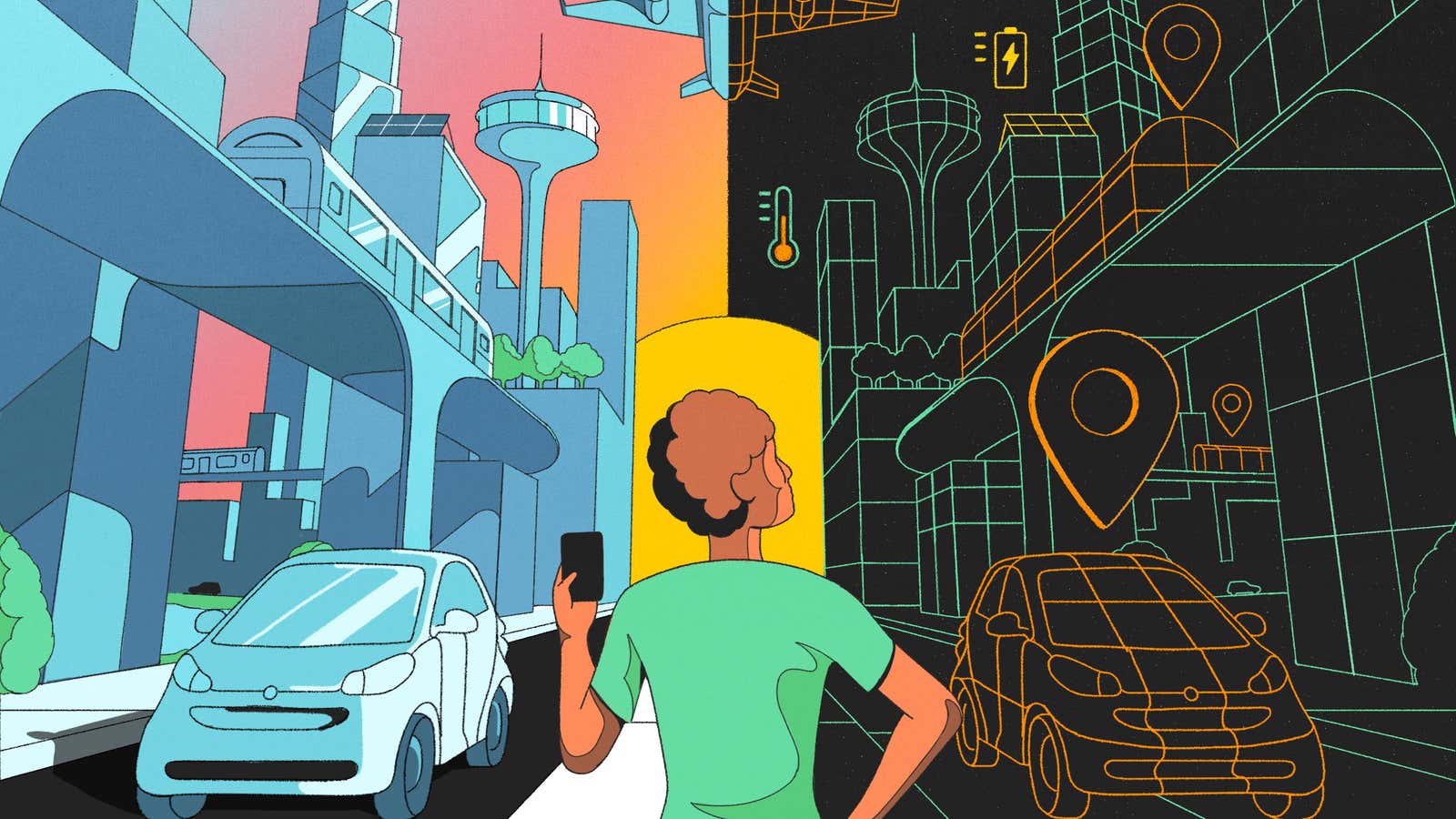
Davos returns later this month. Follow along with our Need to Know: Davos popup email.
Hi Quartz members,
When you commuted to your job this week, chances are you didn’t arrive by flying car. When you ordered a coffee at your local coffee shop, the barista who took your order wasn’t a hyperrealistic android.
Much of the technology promised in science fiction descriptions of “cities of the future” has yet to be realized, but cityscapes continue to be canvases for technological innovation, and it has fundamentally transformed our urban landscapes. Ride-hailing has revolutionized the way we get around; 5G public internet is making cities more connected than ever; just last month, South Korea unveiled a plan for an entire floating city, built to withstand rising sea levels.
In recent years, urban planners and government leaders have embraced new technology through the “smart city” concept—the idea that a wide range of digital tools can be used to collect data and connect city systems, allowing them to run more efficiently. More than a decade on, however, the smart cities movement hasn’t delivered on many of its promises, and has been criticized for the way it compromises privacy.
Given the rapid pace of change cities have already undergone, what will tomorrow’s cities look like, realistically? Not all cities will forge ahead at the same pace, of course. Places that are already part of wealthy, developed economies will be better positioned to take advantage of emerging tech while others will get left behind. Even so, technology will certainly change the way cities look and function. Here are four areas to watch.
🔮 #1: A better kind of building
Urban built environments cover only 3% of the earth’s surface, but make up nearly 40% of global greenhouse gas emissions. In the future, they’ll need to be much more sustainable while also becoming more affordable and multipurpose than they are today.
Take for example the iconic glass-and-steel skyscraper office tower that dots city skylines around the world today. In the future, that building may be made of more environmentally friendly material, like mass timber, instead of steel and concrete. Maybe, in addition to having solar panels on the roof, entire facades will also capture solar energy. All of its heating and cooling systems will be powered by electricity that’s tied to a renewable energy grid, and all the electricity in the building will be managed by a central control system that automatically shifts energy use to make it as efficient as possible. And maybe that tower doesn’t just house offices, but includes residential and real estate space as well. Maybe it allows the same group of city residents to live, work, and play in the same space.
Creating such complex, dynamic buildings will require a complete rethinking of the building process in cities, from design, to construction, to operation, explains Bill Ruh, CEO of Lendlease Digital. The company is part of an international real estate company that creates digital software to streamline the property supply chain.
“We’re going to have to find ways to drive toward more efficient building because we just won’t have the labor to do it the way we’ve been doing it. I think the risk of slowing down is a big one.”
Ruh sees a role for digital technologies like machine learning and modular building to play a role in automating building design and operation so that more “smart” buildings can get put up more quickly and more cheaply.
“We’re going to see much more advanced AI and analytic tools at the front end for the developers, and we’re going to see suppliers move to a ‘Lego block’ approach to building. They’re going to have to figure out how different pieces fit together so that they can be constructed in a quicker, more sustainable way,” says Ruh.
🔮 #2: Sensors on everything, not everyone
At the heart of the idea of a smart city is a network of interconnected sensors, cameras, and devices that are constantly collecting and analyzing data about a number of metrics—an internet of things, if you will.
IoT technology has been used in cities for years, but people began to question what data was being collected, and to what ends. Technology such as traffic monitoring, facial recognition software, and location tracking have been criticized for being used as surveillance tools and violating privacy rights.
But now there’s a shift underway among urban planning scholars to encourage cities to shift away from monitoring people to monitoring systems. Cities have started to use sensors and robotics to measure and control things like air quality, wastewater, flooding, and street lights.
Going forward, sensors will have an even greater role to play in monitoring the built environment. Cities will increasingly use computer vision and AI to evaluate the condition of roads, bridges, and sewers in order to make repairs more quickly. Sensors will be used in managing waste, monitoring noise pollution, and even preventing train collisions.
“What you measure matters,” says Mike Bloomberg, an urban technology researcher at Cornell Tech, part of Cornell University (no relation to the former New York mayor). “We’ve been so focused on collecting data on people and we should instead reduce the amount of data on people and massively increase the amount of data that we collect on physical infrastructure.”
Rankings interlude
Where are the “smartest” cities today? Researchers at the Singapore University of Technology and Design and the International Institute for Management Development teamed up to create an index of 118 “smart cities” around the world. Using survey data from residents, the researchers ranked the cities on the strength of their institutions and structures, like mobility, safety, and governance, as well as the degree to which technologies were integrated into all these areas to make them more accessible and efficient for residents. Here are the top 10 smartest cities for 2021:

🔮 #3: Autonomous delivery

The way people get around in cities will continue to change, including more electric vehicles, fewer vehicles in city centers, more ride-hailing, and more “micromobility” options like scooters.
But the biggest change in city transit will center on the movement of goods, not people. If the boom in e-commerce continues, as retail industry analysts expect it to, cities and companies will need to devise new solutions for warehousing, fulfillment, and delivery in urban spaces. Cities will need to embrace last-mile delivery vehicles that don’t burn fossil fuels, such as drones and e-cargo bikes. Anthony Townsend, an urban planner and author of the book Smart Cities believes package delivery to be one of the best candidates for autonomous vehicles.
“Automation is easier to do when people aren’t involved. You don’t have to keep passengers safe, you can operate at much slower speeds, and you can operate on a smaller part of the road network,” says Townsend.
Already, Fujisawa Smart Sustainable Town, a designated smart city area in Fujisawa City, Japan, has experimented with autonomous delivery robots. On a larger scale, freight carriers are exploring AV technology for driverless trucks, to move large amounts of cargo over long distances.
🔮 #4: The virtual city
More and more city functions will move online—and into the range of virtual technologies known as the metaverse. Seoul, South Korea became the first municipal government to develop its own metaverse platform in 2021, where it plans to host a variety of municipal functions, including a virtual city hall, and a number of cultural events. The government of Catalonia, Spain, has also announced its own metaverse, to be used primarily by businesses.
Much like their big tech counterparts, these “municipal metaverses” don’t yet have very many applications and are unlikely to ever fully replace physical cities for most people. At this point, they’re more of an outreach tool for city governments, to connect to residents and attract tourism and business.
A more functional virtual tool for many more cities is digital twin technology. It’s software that creates a digital replica of an entire city’s geography, including buildings, roads, and subterranean infrastructure like sewers and subways, recreated accurately down to the smallest detail, and updated with changes in real time.
Even if it’s something the typical city resident never sees, digital twins can be invaluable to urban planners because they allow cities to model out infrastructure projects, building construction, and other changes to the built environment and evaluate their impacts in the real world, all before ever breaking ground. It’s going to change the way cities build, according to Mike Bloomberg.
“Digital twins aren’t just about visualizing objects in virtual space, but understanding the data points associated with it, which is much harder to do,” says Bloomberg. “It can save trillions of dollars in infrastructure spending, and help prevent catastrophes like building collapses.”
Keep learning
What’s in store for empty downtown office buildings? (Quartz)
Connectivity trends for smart cities (Smart Cities World)
New York City’s natural gas ban is a major milestone for city climate policy (Quartz)
How cities are using digital twins like a SimCity for policymakers (Bloomberg CityLab)
Architecture’s most prestigious prize honors the genius of sustainable buildings in Africa (Quartz)
The future of last-mile delivery includes drones (FreightWaves)
📣 Sound off
Which trend in city tech are you most excited about?
Last week, 41% of you said more research was needed before we release genetically modified insects. Better safe than sorry.
Have a great week,
Camille Squires, cities reporter (still holding out for hoverboards)
ONE 💸 THING
Miami mayor Francis Suarez is bullish on a different technology: blockchain. He’s backing a city-specific cryptocurrency called MiamiCoin. City tech experts think there are a number of exciting possibilities for blockchain to improve security and transparency for smart city technology, IoT networks and digital identification cards. But cryptocurrencies? Not so much. “All the energy right now is going into crypto,” says Anthony Townsend. “Which is unfortunate, because it’s just gambling.”
